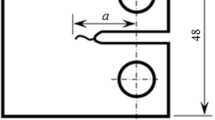Abstract
The surface crack is a common flaw in structures and vessels, and its elastic characterization has been studied extensively as reviewed in Ref. 1 and its references. Elastic-plastic fracture-mechanics (EPFM) technology can be used to characterize surface cracks in tough materials. Two EPFM aprameters are commonly used: the crack-tip-opening displacement (CTOD) and the three-dimensionalJ integral. This paper draws on a series of studies2–11 at the National Bureau of Standards related to the development and verification of analyticalmodels for the calculation of EPFM parameters in surface-cracked tensile panels. The models previously verified for pipeline steel plates4–7 are used to calculate the crack-mouth-opening displacement (CMOD) andJ for surface cracks in welded-steel specimens.
Similar content being viewed by others
References
Benchmark Editorial Committee of the SESA Fracture Committee, “A Critical Evaluation of Numerical Solutions to the ‘Benchmark” Surface-flaw Probem,”Experimental Mechanics,20 (8),253–264 (Aug. 1980).
McHenry, H.I., Read, D.T. andBegley, J.A., “Fracture Mechanics Analysis of Pipeline Girthwelds,”Elastic-Plastic Fracture, ASTM STP 668, ed. J.D. Landes, J.A. Begley andG.A. Clarke, Amer. Soc. for Test. and Mat., Philadelphia, 632–642 (1979).
Reeed, R.P., McHenry, H.I. and Kasen, M.B., “A Fracture Mechanics Evaluation of Flaws in Pipeline Girth Welds,” Welding Res. Council Bull., 245 (Jan. 1979).
Cheng, Y.W., McHenry, H.I. andRead, D.T., “Crack-Opening Displacement of Surface Cracks in Pipelines Steel Plates,”Fracture Mechanics: Fourteenth Symposium—Volume II: Testing and Applications, ASTM STP, 791, ed. J.C. Lewis andG. Sines, Amer. Soc. for Test. and Mat., Philadelphia, 214–231 (1983).
King, R.B., Cheng, Y.W., Read, D.T. andMcHenry, H.J., “J-Integral Analysis of Surface Cracks in Pipeline Steel Plates,”Elastic-Plastic Fracture: Second Symposium, Volume I—Inelastic Crack Analysis, ASTM STP 903, ed. C.F. Shih andJ.P. Gudas, Amer. Soc. for Test. and Mat., Philadelphia, I-444–I-457 (1983).
Cheng, Y.W., King, R.B., Read, D.T. andMcHenry, H.I., “Post-Yield Crack Opening Displacement of Surface Cracks,”Steel Weldments, Fracture Mechanics: Fifteenth Symposium, ASTM STP 833,ed. R.J. Sanford,Amer. Soc. for Test. and Mat.,Philadelphia,666–681 (1984).
Reed, R.P., Kasen, M.B., McHenry, H.I., Fortunkno, C.M. and Read, D.T., “Fitness-for-Service Criteria for Pipeline Girthweld Quality,” Welding Res. Council Bul., 296 (July 1984).
Carpenter, W.C., Read, D.T., “Comments on the Evaluation of the J Integral,”Int. J. Fract.,26,R71-R84 (1984).
Carpenter, W.C. andRead, D.T., “Estimation of Critical Values of the Potential Energy Release Rate,”Int. J. Fract.,29,233-R26 (1985).
Crpenter, W.C., and Read, D.T. and Dodds, R.H., Jr., “Comparison of Several Path Independent Integrals including Plasticity Effects,” submitted for publication in International Journal of Fracture.
King, R.B., “Elastic-Plastic Analysis of Surface Flows Using a Simplified Line-Spring Model,”Eng. Fract. Mech.,18,217–231 (1983).
Irwin, G.R., in The Surface Crack: Physical Problems and Computational Solutions, ed. J.L. Swedlow, Amer. Soc. of Mech. Eng., New York, 1–10 (1972).
Dugdale, D.S., “Yielding of Steel Sheets Containing Slits,”J. Mech. and Physics of Solids,8,100–108 (1960).
Kobayashi, A.S., “Crack Opening Displacement in a Surface-Flawed Plate Subject to Tension or Plate Bending,” Proc. 2nd Int. Conf. of Mech. Behavior of Mat., Amer. Soc. for Metals, Metals Park, OH, 1073–1077 (1976).
Newman, J.C., Jr. and Rajus, I.S., “Analyses of Surface Cracks, in Plates Under Tension or Bending Loads,” NASA TP 1578, Nat. Aero. and Space Admin. (1979).
Rice, J.R. andLevy, N., “The Part-Through Surface Crack in an Elastic Plates,”J. Appl. Mech.,39,185–194 (1972).
Delale, F. andErdogan, F., “Line Spring Model for Surface Cracks in a Reissner Plate,”Int. J. Eng. Sci.,19,1331–1340 (1981).
Read, D.T., “Experimental Method for Direct Evaluation of the J-Contour Integral,” Fracture Mechanics: Fourteen Symposium, ASTM STP 791, Amer. Soc. for Test. and Mat., II-199-II-213 (1983).
Author information
Authors and Affiliations
Rights and permissions
About this article
Cite this article
Read, D.T., McHenry, H.I. & Petrovski, B. Elastic-plastic models of surface cracks in tensile panels. Experimental Mechanics 29, 226–230 (1989). https://doi.org/10.1007/BF02321380
Received:
Revised:
Issue Date:
DOI: https://doi.org/10.1007/BF02321380




